Category: Cover story
miscellaneous-cover-story
2023 is a year that has given again outstanding performances in this “golden” age that we are lucky to experience nowadays: The victories of Van der Poel in Milan-San Remo or Paris Roubaix, Evenepoel‘s exhibitions in Liege-Bastogne-Liege or San Sebastian Classic, Pogacar epic win in Tour de Flandes and his epic battles with Vingegaard in Tour de France, Roglic winning in the last time trial the Giro de Italia against the combative old lion Geraint Thomas… and on and on.
But oh, what we were able to see in Glasgow a few days ago was, maybe, the best classic one single race of the year 2023 and one that will be in the memory of cycling fans for years to come (I only remember enjoying a World Championship so much many years ago, the WC in Colombia, with Olano, Indurain and Pantani in the podium after a grueling and super exciting mountain course).
We leave you here the video if you want to watch again this historical event, and we give you some of the analysis of the race:
- The course
It was criticized by many fans and riders alike, but in the end you have to give to the organization that the course track was perfect for entertaining. With no long climbing, but with explosive obstacles disseminated in a very technical circuit with a lot of turns left and right, this race looked almost like a cyclocross race on asphalt. Positioning was the key if riders wanted to have a chance to win in the end, cause recovering positions was really really complicated. - The riders’ attitude
It is an old saying in professional cycling that the hard a day race is depends more on the riders than on the course itself. Here in Glasgow we saw fireworks from the favorites from… 150 kms to the finish line! Alaphilippe attacking, strong teams like Denmark or Italy trying to break hostilities from the first laps in the circuit, attacks from big names like Van der Poel, Evenepoel, Pogacar, Pedersen with 100 kilometers to go… it was a marvellous madness of a race in an age where so many times spectator has to wait to the last kilometers to see some action happening. - Italy is always there
They might not have always the strongest riders, although Trentin (sadly out cause of a crash) or Bettiol were serious contenders, but you cannot deny their compromise and their attitude as a team. They attacked when needed to attack, they worked great as a formation and Bettiol’s sneaky attack was just one lap away from giving him the victory.
The same cannot be said of other teams like Spain, pretty much disappeared without options most of the race, or even the great favourites, Belgium itself, where the team seemed fractured most of the race between defending the interests of Wout van Aert and Evenepoel trying to win his second WC in a row.
4. The big names do not disappoint
Van der Poel: He has shown in 2023 that he is probably the strongers classic races rider in the world nowadays. He has learnt how not to waste too much energy through the race and improved tactically to the point that the spots where he launches the final attacks are perfect. And of course, all that backed up with the incredible explosive power that his legs are able to carry. He was the strongest rider of the day, and not even a crash in the final kilometers could deprive him of a well deserved victory
Pogacar: If you like professional cycling, you have to like Tadej Pogacar. A man not afraid to compete and give everything both in 3 weeks races or in the most demanding classics of the year. To his disadvantage, he had to spend too much energy reacting to attacks way too far from the finish line, and in the last 2 laps he recognized that he was already suffering. But in any case, it is always a big show to see him race and attack. He does not leave anything left in his tank, and the bronze medal is a more than fair reward to his attitude and talent.
Wout van Aert: Again another silver medal for his collection. And again the feeling for many fans that, even when Van Aert is one of the biggest cycling talents arousing in the last years, he is wasting too many good chances to achieve more remarkable victories year after year. In Paris Roubais was an unfortunate puncture at the end of the last pave section. Today he just lacked the legs to follow Van der Poel in his decisive attack. For many other riders, a silver would be a fantastic result, but for Van Aert, the bittersweet feeling of another great chance missed is there. We hope that some day we can see him wearing the rainbow jersey. His talent deserves it.
Evenepoel: it is true that with such a technical track, Evenepoel did not have it easy to repeat victory in Glasgow. But from the favorites, his performance was certainly the most surprising. He got himself cut several times from the lead bunch due to bad positioning, then when it seemed like he did not have the legs, he performed a couple of strong attacks, and then again he got cut and gave up on pursuing… For much that he is one of the most talented riders out there, explosive, maybe the best time-trial specialist in the world, and a pleasure to see him attacking faraway, he should improve still a lot on his mental focus if he wants to be a consistent winners against the strongest opponents out there.
Enni Rukajärvi has already become a living legend in the history of Finnish sports after achieving her second Olympic medal at PyengChang during last winter. Bringing the focus and attention to female participation in winter sports in Finland, she is an example of endurance, perseverance and skills owning an adventurous spirit hungry to overcome the next challenge. FREE! Magazine had the chance to send her a few questions about her past, present and future. If you want to see her amazing snowboarding skills live, you can have soon the chance to see her competing in the incoming X Games to be celebrated in Norway between 18-20 of May.
First of all, thanks a lot for attending FREE! Magazine’s questions, Enni! You competed recently last February on the Olympic Games at PyeongChang, where you got a bronze medal in slopestyle and also competed in Big Air discipline. How was the general experience there in South Korea and your memories of the competitions?
-I liked South Korea, people were nice and food was good. Everything worked pretty well, slope style course was well built and Big air jump was nice too. Just the windy conditions were a down side and it was one of my scariest moments to compete in those crazy windy conditions during the slopestyle.
In what ways was similar or different to your previous first (silver) medal in Sochi in 2014?
-In many ways it was different, first of all Sochi was my first Olympics so I didn’t know what to expect at all and also during the Sochi games I was injured and not sure if I was even able to compete so it was a big battle to even make it happen. I felt way more pressure there and I got quite a lot media attention in Finland. After I landed my last run in Sochi I was just so happy to land a run after all the struggle I have had there and I was also happy that it was finally over.
Going to South Korea everything felt way more easier and less exciting because I already knew what to expect. I also felt less pressure. It was such a shame we had to compete in that crazy weather but again after my second run I was just happy to land a run and survive. Also all the media attention after getting the medal felt easier this time.
Was it demanding to participate in both slopestyle and air competitions during same Olympics? If I am not mistaken, this was the first time that Air was introduced in the Olympics. Do they require any particular separated training/mind set for each discipline?
-Yes and no, for sure slopestyle took a lot of energy already but Big Air is kinda easier especially after slopestyle when you only need to concentrate on one jump instead of a whole run. For me it doesn’t require different mind set or training, I think they go hand in hand.
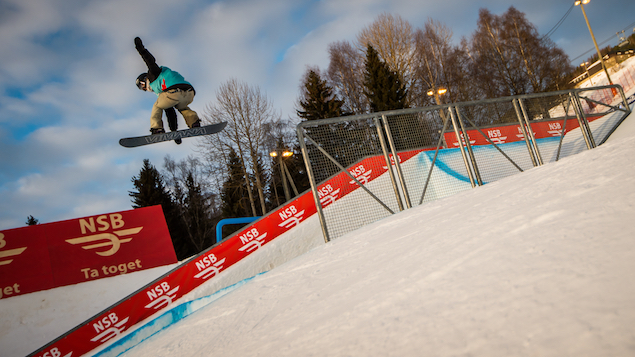
Could you tell us how and why you started practicing snowboarding?
-My home is really close to a ski resort in North of Finland where the winters are long so it was kinda natural thing to do. I started skiing first and then I wanted to try snowboarding because it looked so cool. Also I was always interested to learn new things and tricks so snowboarding was perfect thing to do.
What is what you love the most about snowboarding?
-You can always learn new things and challenge yourself and do it with your friends without rules.
I have heard that you pretty much love practising many other kind of sports too. What do you do when you are not snowboarding?
-Skateboarding, gym, yoga, biking, jogging, different kind of games like basketball, beach volleyball etc..pretty much everything
Snowboard practice looks a lot of fun but certainly there is always a big risk of injuries. How do you face the situations when you have hurt yourself and then you are back on the snow? Do snowboarders have a bit of special mind set to disregard the risks?
-Always after injury it takes some time to get 100 % back, but best way for me is just start riding and doing really easy tricks to built the confidence back and when you do that at some point you just feel as good as before and you are ready to try new tricks again. For sure snowboarders have a bit of a special mind set for everything and you don’t think about the risks that much when you are snowboarding.
Following up the previous question, when the years pass by practicing the sport, do you always keep the attitude the same or is there some moment when you can think of a jump or a trick that you would have tried with no hesitation when being 17 but then you feel more cautious to try when you have competed for several years?
-For me I think that goes other way around actually, I have always been pretty hesitated and thought through really well before I try anything new. I’m way better rider now so I know I can try crazier things now than when I was 17 so with my experience I have got to be less hesitant about trying new stuff.
When you are competing, do you have any particular routine to concentrate in the minutes/seconds before being ready to start on the ramp?
-I kinda do. I like to listen music, think about my run and be on my own a little bit and just before I drop in I try to think about something else.
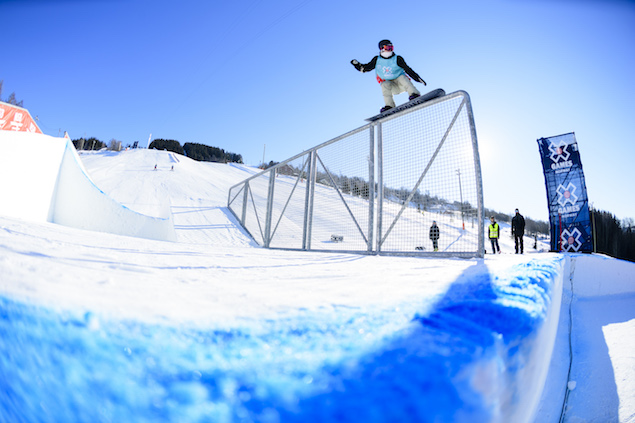
What are your favourite places for snowboarding that you have visited around the world? And favourite competitions?
-Japan for sure, I love snow and Japan has a lot of snow! And my favorite competition has always been European Open called Laax Open nowadays. Laax is also a really fun place to ride because they have everything from jumps to rails, pipe and pow!
When seen from outside, the atmosphere around snowboarding always looks happy and easy going. Is it easy to make new friends around the tour circuit?
-I think it is, especially on the girls side we all hang out together. I think the atmosphere is pretty welcoming for the new younger riders.
Are there any other snowboarders that you particularly admire?
–Markku Koski and Arthur Longo and many more
Have you thought in the future what would you like doing when you will stop competing at high level? Would you like to continue linked to the sport, or try some other areas?
-I hope next I could start filming video parts and riding more pow. After that I’m not sure, I think I will always stay in snowboarding somehow maybe do some other stuff too, will see.
You are confirmed as one participant in the incoming X Games in Norway that will take place in May. What are your expectations about the event?
I’m really excited about it, I think it’s gonna be a really different experience again. I also like Norway so it should be fun!
Anything else you would like to add for your readers?
-Let’s go snowboarding!
For more information about X Games in Norway, visit: http://xgames.espn.com/xgames/norway/
Photos by ESPN IMAGES
Tickets to Norway’s biggest action sport event ever are now available online. The world’s best snowboarders, skiers and skateboarders will meet in Oslo to compete for prestigious X Games medals, to the backdrop of a musical and cultural extravaganza in the Norwegian capital.
Ticket prices are being kept accessible so the entire family can watch X Games Oslo together.
Some of the events at the inaugural X Games Oslo will have facilities to accommodate large numbers of spectators, while others are limited. The biggest arena is located at Tøyen, where 15,000 tickets are available for the Big Air finals, at which skiers and snowboarders will compete on the same day. There is seating for 9,000 spectators at Wyller for the Skiing and Snowboarding SuperPipe finals. The smallest arena is Skur 13, at the Filipstad wharf, where only 1,000 tickets are available for Skateboard Street (indoors).
The event will also feature concerts and entertainment at the Tøyen arena, the X Games Oslo Village and its collaborative partners will offer innovative fun activities for the public, and parties will be held all over the city.

The world’s greatest athletes are ready for Oslo
50 action sports superstars have already qualified for competition, and among them are the Scandinavian Ståle Sandbech, Silje Norendal, Tiril Sjåstad Christiansen and Kjersti Buaas from Norway and Peetu Piiroinen and Roope Tonteri representing Finland.
The world’s best skateboarders are making their way to Oslo: Nyjah Huston, Chris Cole and Curren Caples. In addition, the lists of competitors for snowboarding and skiing are full of world champions, Olympic medal winners and stars of action sport films.
“We will be bringing together the most experienced athletes from all around the globe at our world-class arenas, so this is going to beat anything that’s ever been done in the past on the Norwegian sports scene,” said former pro snowboarder and head of the sports committee at X Games Oslo, Stine Brun Kjeldaas.
The countdown has already begun. The world’s toughest action sport event is on its way to Oslo, with banners flying: X Games Oslo, February 24 to 28, 2016.
Street Hockey Tour 2014
Street Hockey, also known as ball hockey, dek hockey or road hockey, is a variation of ice hockey where the players play on the ground with sneakers or rollerblades instead of on ice with ice skates. This is why this sport is easy to play and everybody can participate, regardless of their skill level. This year 144 team were chasing the Finnish Street Hockey championship title.
Street Hockey is usually played on asphalt which is why helmet and ice hockey gloves are mandatory equipment. Although it’s also recommended to use protective cup and knee pads. In Finland the Game time is 2 X 10 min. and in this sport the gaming time doesn’t stop during the game breaks. Street Hockey is played with a small plastic ball.
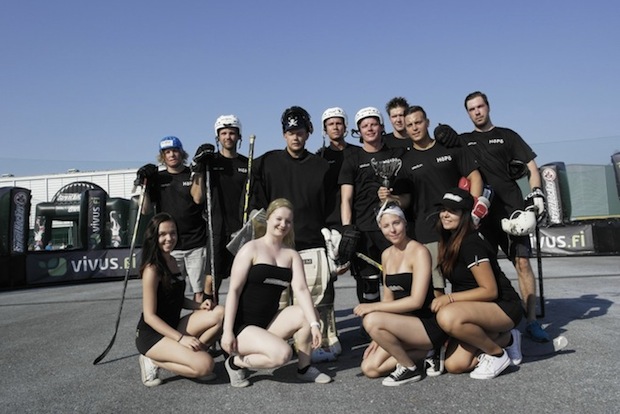
Street Hockey Tour has been arranged in Finland already for ten years, and the popularity is increasing year after year. This summer Street Hockey Tour celebrated its eleventh year touring around in Finland. This also means that there are eleven happy teams with the Finnish championship title in Street Hockey. This year the tour started in the beginning of June, with the first qualifier arranged in Helsinki 7-8.6.2014. Altogether the tour was arranged in 7 different cities, and in total there were 14 eventful days during the Finnish Street Hockey championship tour. The tour was culminated with the Finals in Helsinki 1-2.8.2014, where the four best teams of each city, altogether 24 teams, competed against each other to win the Finnish championship. The title of The Finnish championship in Street Hockey year 2014 was won by Jaybirdz team from Tampere. The second team was American diner and the bronze was won by a team called Joukkue. You can check out pictures from the whole tour here.
The tour this year was arranged in following cities: Turku, Rauma, Tampere, Jyväskylä, Oulu and the finals in Helsinki. From these cities the following teams were able to struggle their way to the finals in Helsinki: Killeri, Joukkue, Vallox Rednecks, American Dinner, HC Puutuneet Jalat, Minnesota Viltti, Texas Pete, Myyrät, Punakone, DPHD, Turtles Hockey, Raimonlätty, Jaybirdz, Örh, HC Nahkanuoliaiset, Radio City, Vuorelan Veikot, HC Nahkatorvi, Pasilan Pyrkijä, HS127, Dynastia, Haamujengi, Hc Kings, and G.G.G.
Tour with 14 eventful days
In addition to the tour and the exciting games, the gaming area was filled with entertainment and events for the audience. Throughout the whole tour the audience had the possibility to test their own strength with the hockey shot radar. One of Finland’s most known hockey players: Jarkko “Rudi” Ruutu tested this hockey shot radar in Helsinki with the result speed of 153 km/hour. And of course the aim of many hockey fans was to beat Rudi in the hockey radar. The speed of the best shot during the whole Street Hockey Tour was over 190 km/hour. Another partner to Street Hockey Tour in Finland was the Finnish online casino Netticasino.com, which provided the audience entertainment in their tent with their roulette and blackjack gambling tables. Netticasino also had a raffle throughout the tour where one lucky winner from Oulu won a season ticket to Kärpät ice hockey team for season 2014-2015. Read the interview with the winner here.
Throughout the whole, almost two months lasting tour, many famous faces were seen and also many hockey players participated the tournament. In Jyväskylä the audience could enjoy games watching Stanley Cup winner Ville Nieminen playing in the Blockfest team. The northernmost city in the tour also provided the audience excitement with a “star game” with Finnish known hockey players such as Juhamatti Aaltonen, Julius Junttila and Joonas Donskoi.
Helsinki finals in August was popped with people and no wonder, since the “star game” at Saturday 2.8.2014 was played with hockey stars such as Esa Tikkanen, Jarkko Ruutu, Leo Komarov, Veli-Matti Savinainen and Juha Koivisto.
Be ready for the next year’s Street Hockey Tour, since for sure there are going to be even more teams participating, and it’s going to be bigger and of course better, so sta
Gambling Culture in Finland
Finland is a country in which the people enjoy gambling. Statistics have shown that a large percentage of Finns have either gambled playing cash games or other games of chance such as the lottery. While Finnish people enjoy various gambling games, the choice is somewhat limited.
Gambling Oligopoly in Finland
While it is not quite a monopoly, but rather an oligopoly that dominates the Finnish gambling market. The main players, each with a monopoly in their specific areas, are RAY, Veikkaus, PAF and Fintoto. Fintoto runs the country’s horseracing. With the introduction of mobile gambling, there are certain changes that are slowly taking place in the gambling culture in Finland.
RAY, Finland’s Slot Machine Association, not only provides gaming entertainment to the Finnish people, the association also helps to support both health and social welfare organisations as well as war veterans. RAY runs its own arcades, and also offers slot machines in a total of 8,000 locations, including hotels, markets, service stations, restaurants, and other locations that are frequented by the general public. RAY operates the only land casino in Finland and offers both online and mobile gaming too.
The Finnish Lottery, Veikkaus, operates a number of games including instant games, pools, and of course, lotto games. Many Finns play the lottery games that are offered in a large number of locations around the country. Veikkaus helps to support arts and culture, science, and sports.
The Alands Penningautomatforening (PAF) company has been offering legal online gambling in Finland. While online gambling has been legal since 1996, it took until 2010 for RAY to get the necessary permission to enter the online gambling market. Fintoto and Veikkaus were also given permission to offer their lottery and horseracing betting online.
Land-Based Gambling and Online Gambling in Finland
Since Finnish people are surrounded by legal gambling games there is clearly a high demand from players. The gambling culture in Finland is thriving and many children are with their parents when the parents play slots around the country. While gaming is familiar and part of life, the Lotteries Act passed a law in 2011 making 18 the minimum gambling age. While children had been allowed to play slots if they were accompanied by an adult, this changed in 2011 with the introduction of this law. Those who are gambling now were introduced to gambling games from a young age.
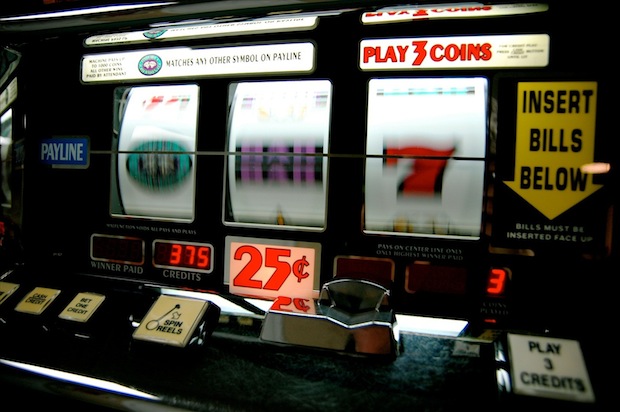
As more households have one or more computers, smartphones or tablets available, online and mobile gambling is becoming more popular. While the percentage of Finns that gamble online is still smaller than that of land-based Finnish gamblers, it is likely that the number of online players will increase over time since Finnish people enjoy games of chance. The EU has ruled that all member countries should allow online gambling across EU borders, however, Finland is resisting this change. Should more online gambling companies be introduced into Finland, it is likely that there will be a rise in the number of players who choose to play online.
Statistics Show How Entrenched Gambling is in the Finnish Culture
In 2011, the National Institute for Health and Welfare designed a survey regarding gambling in Finland. The survey was conducted between October 2011 and January 2012. The survey showed that 78% who responded to the survey had gambled during the past 12 months. The percentage is only slightly up from the 74% result in the 2007 survey. There have been no significant changes between the 2007 and the 2011 studies that took place.
85% of respondents showed that there is a general feeling that raising the legal gambling age to 18 has been a good move and will reduce the number of problem gamblers. 75% of those who were polled feel that it is a good thing that gambling is controlled by the state.
Related articles:
http://www.freemagazine.fi/top-5-gambling-locations/
http://www.freemagazine.fi/estonia-is-not-only-about-cheap-booze-easy-women-and-gambling/
Beer vs. Wine
Written by Alex Hillsberg
It’s an age-old debate, probably as old as the most antiquated oak barrels and brew pots. Behind the waggish claims from both beer and wine camps, sober or otherwise, lies a serious battle to wrestle market shares in developed and emerging markets and across generations.
If we go by votes, the people who altogether consumed 189 billion liters of beer in 2011 clearly outnumbered those who drank wine for a collective 24 billion liters in the same year. But sales can be misleading.
As highlighted in the infographic below, wine is gaining popularity—more pronouncedly in the United States according to a Gallup survey—even as beer consumption is sliding down in traditional markets, such as, horror of horrors, Germany. Early this year, Time reported that beer drinking hit a record low in the land of lederhosen and dirndl.
It didn’t also help for brewers that China, the number one beer market, is developing a taste for wine. In fact, Great Wall, the number two wine brand last year… great what? Exactly. The Chinese wine is a newcomer and was hardly known brand in the industry three years ago. Just last year it easily took the second spot spurred by millions of Chinese who started liking wine. “We will make a French Great Wall, a Chilean Great Wall and an Australian Great Wall,” Shu Yu, a senior manager at the company behind Great Wall, said. Brewers may not be the only ones paying nervous attention to this upstart, but the other top wine makers, too (check their rankings below).
Meantime, brewers lament that wine lobbyists hijacked most of the health claims. Beer is healthy, too, they say, at least in some respect as pointed out below in the infographic, notably that beer is kind to kidneys.
Likewise, one subtle but significant data we uncorked is that wine drinkers’ preference is more evenly spread than beer drinkers’. Cabernet, Merlot, and Pinot Noir among reds and Chardonnay, Pinot Grigio, and Sauvignon Blanc among whites are the top varieties of choice. For beer, only two styles—pale lagers and pilsners—account for most of the top beer brands. Does it suggest wine drinkers have a more sophisticated taste? We dare not ask a Bavarian.
So who wins? Maybe it depends on when you ask the question. This season of Oktoberfest celebrations around the world, it may be advisable to quietly sip and enjoy your wine in one corner. Prost!
Text by Eva Blanco
Marimekko is all about colour. That is the first thing you realize when you step into the headquarters of the brand located in Herttoniemi (East Helsinki). Suddenly your eyes start travelling from one canvas to another – their patterns being all around the building as part of the interior decoration-, and you get the growing conviction that you have just entered into some kind of wonderland, where people are stylish, smile at you for no reason, and, most probably, are also able to levitate and make themselves transparent to avoid being disturbed. Anything is possible when you are surrounded by all those fabrics printed with their daring designs. But, be careful before continuing to read! It has been proved recently that colour, when consumed in large quantities, may have dangerous consequences on your brain – it can enhance your creativity or put you in a summery mood! We have already warned you, from now on, it ́s your own responsibility!
Translated into English, Marimekko means “Mari’s dress”. Mari, Mery, María… For Armi Ratia, who founded the brand in 1951, this ubiquitous name contained two of the most fascinating characteristics, simplicity and functionality. All of us – you too, unless your mother was told you were to be a boy- could have been Mari. That is why it seems so easy to identify ourselves with the name, maybe as easy as Armi wanted it to be for all of her fellow citizens to be able to also identify with her textile designs. A personal wish that, more than sixty years later in the history of the brand, has not only been widely accomplished but indeed seems modest compared to the growing international dimension of the house.
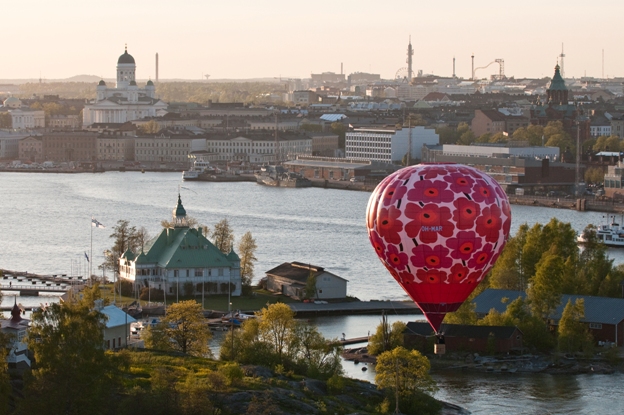
In 2011, the year of its half-century anniversary, Marimekko opened its own flagship store on the corner of Fifth Avenue and Broadway in New York, together with six more commercial spaces in the United States – especially located on the West Coast. Plus, due to the strong sales growth, the Asia-Pacific region became the brand’s second-biggest market, following the lead of Finland, which represented up to 64% net sales in the same period. Last year the company entered the Chinese market via Hong-Kong, thus securing a concrete business strategy that has been defined by its President and CEO, Mika Ihamuotila, in these words: “Dynamic expansion requires patience from the company and its shareholders, but I am convinced that this will be fruitful for Marimekko in the long term”.
With the arrival of Spring , Minna Kemell-Kutvonen, Marimekko’s Creative Director, has allowed us into their offices and beloved textile printing factory so that we can visit them and discuss the future challenges a brand with a well defined local identity needs to confront when its products are being sold in approximately 40 countries. Minna gives me a firm handshake, smiles generously and, as if to break the ice, confesses that it feels so good to finally have a face to face interview, rather than speak only by phone as she had been doing lately. Then, when she begins to talk with passion about the brand’s creative philosophy, I can’t help wondering…Would it ever have crossed her parent ́s mind to have called her Mari? After all, both names did start with a capital “M”.
If you had to describe the brand to somebody who has never heard about it, what would you say?
All in all, Marimekko is an aesthetic understanding and interpretation of our everyday life. We translate it into shape, colours and patterns. We could say that it is more like a way to live. More than sixty years of history has proved that our aim is to be present in every detail of our customer’s world – not only through fashion and clothing but also through fabrics where print creates a special atmosphere in the home, or even through the cups you use for your daily coffee break!. When you are an aesthetically orientated person, and you love to arrange space in a particular way, you have to take into account that you look at the same objects constantly and, thus, a very special bond needs to be established with them. So, I believe they are also an active part of your life.
Then, of course, there are some days when you wake up longing to introduce some new, and often contradictory, products into your personal space, and though it may seem to be a little disturbing for the usual harmony, by doing that you can find something truly fresh. In this house we are always open to these kind of contradictions. For instance, if you think about our history, in Finland it is commonly known that the creation of the brand after the war, in 1951, coincided with a time when the most part of the population living in the countryside decided to move to the cities. And their life there was different from the one they used to have back in their villages, their regular activities now were much closer to the academic spheres and to the office work. So, from Marimekko they were able to find some of those things they were missing the most from their homeland…maybe even some emotions like the one inspired by the sunrise, interesting winds, rocks, sea landscapes….In short, they brought a reinforced romantic feeling back into their lives. And that ́s how the brand became a part of them.
So, we could conclude that some concepts such as the reinterpretation of the rural world, or the search for comfort inside the Finnish nature are key issues for the company…
Of course those are key concepts for us, but, if you think about the present context, now that people have been living in the cities for several generations, there is a growing opposition between constructions and natural spaces. And I consider this to be a very interesting collision concerning both nature and architecture: they must coexist together, understand each other, and somewhere in that dialogue there is an intersection which Marimekko also tries to be part of.
So, how would you say the creative philosophy has evolved over more than sixty years of history?
The main idea for our creations is related to the aesthetic thinking. In every decade we have trusted our designers intuition, how they perceive the world and reflect the time they are living in through their compositions. But I have to say that now the world has become bigger for us as a brand than it used to be. We didn ́t operate at the same international level in the past as we currently do – though we had some interesting global contacts, we worked mostly in Finland and Scandinavia. Our beginnings go back to the first printed fabrics, which later on were transferred to women’s fashion collections. Back then we were a smaller company, but now that we are immersed in a global market with customers in varied locations, we need to have a deeper understanding of different cultures and religions, as those are two of the factors shaping people’s everyday lives.
Thus, we try to conceive our designers ideas and creations also as an ingredient of the global discussion. In Finland, due to our geographical situation, there is a very interesting conversation taking place between East and West, and we got a lot of influences from the Russian esthetic but, at the same time, also from the whole of Scandinavia that surrounds us. Also, Finnish people we are quite practical – we tend to solve things without complicating matters. I believe that approach has helped us in Marimekko to give effective answers in this new era of global demand.
What do you consider to be the main challenges for the future in this global market context?
In my view, one of the biggest challenges we will have to face in the near future is maintaining our ability to discuss and look at things from an open perspective – normally the creative team have that broad vision, but sometimes they are also challenging. So, as a designer, you should follow your intuition and expertise, but at the same time you are required to be receptive to that demands coming from people located in different market areas, like, for instance, the west coast in US.
Can you tell us a little bit more about your main markets nowadays?
Well, basically we would be talking about Finland, Japan and the Scandinavian countries. Then, in the last two years we have opened stores in the U.S, Hon-Kong and Australia. So it is very exciting to compare all these different markets, and realize that, despite the cultural gap, people act in a coincidental way everywhere. There is not such a dramatic difference if you look at the broad landscape. All of us have to sleep, eat and to go to work, and, at the emotional level, we are all looking for similar things. Plus, the Asian market seems to be really close to the Scandinavian one, overall in the kind of attitude they manifest…they are more profound, sophisticated, quieter!.
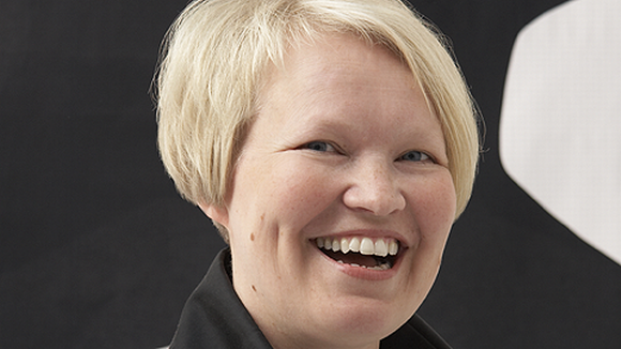
Due to its undeniable success, the Unikko pattern (1964) was one of the main achievements in the Marimekko’s history, which other do you have?
First off, let me give you a little context on the Unikko pattern. Armi Ratia, the founder of Marimekko, had strictly told the designers she didn ́t want to see any flowers in their patterns because natural flowers are already so beautiful and there was no point in trying to copy them for our fabrics – she thought it was not possible to capture that beauty. However, moved by a very strong inspiration, our designer Maija Issola decided to draw a floral pattern so powerful that Armi herself couldn ́t deny its authenticity and spirit. So, through that independent way of thinking she created this graphical flower from her own perception and interpretation of this natural gift. In my view, it contains a very strong attitude that gets reinforced through the graphical elements. You can immediately see there is an intense flow coming out of it, and, either you love it or you hate it, but it certainly won ́t allow you to remain impassive.
Then, I think there are some other momentous in our history as a brand that have to be mentioned, like when at the beginning we started to adapt our printed patterns to female fashion collections – mostly dresses made of cotton. Also, in the early the seventies, we printed our canvas back packs and launch them to the market, it consisted on a very basic pattern suitable both for children, students and also for women going to work. Last but not least, we have our “Tasaraita” pattern (“even stripes” in English) designed by Annika Rimala in 1968. This fabric became an icon of the equality thinking, cause both men and women could wear it on their clothing. The message it sent was that everybody was at the same level. So, it had a big impact on society… and we are really proud of it.
What can you tell us about the work atmosphere in Marimekko?
At Marimekko we usually have open and fruitful discussions related to the projects we are developing, I guess it is because we are a very flat company. So, we are working quite closely to each other, and, though of course we have at the same time built up a well-structured organization, in any case there is a lot of interaction and dialogue among employees.
How do you normally face a new collection?
We start with a “kick off meeting” in which we settle the main theme the collection is going to be based on. Then, we launch this theme to our designers and establish some kind of deadlines to see how the three lines of the collection ( fashion, interior, and bags and accessorizes) work together. Once we have decided which designers are going to be in charge of the different parts of the collection, they start to sketch inspired by the theme we have settled on at the first meetings. We try to meet with them every week – most are freelancer designers, so they don ́t have their studio at the headquarters- and agree on some guidelines for the next steps of the creative process.
Which kind of themes do you usually work with? Can you give us an example?
Our themes are usually very abstract – and quite open in any case! That way it’s easier to come up with fresh and innovative ideas. Once the designers show us their first sketches we can start the discussion to add new concepts to their proposals. For instance, the upcoming fall collection (2013) is based on how beautiful different kinds of weather are, like rainy days with their gray skies, and the emotions they make you feel…we try to reflect that on our lines. Our designers have to find out which different elements the changing weather can bring to you, how you are exposed to it or interact with it. Actually, there are many angles to look at it, sometimes the final images on the patterns are more concrete, some others the whole process gets really subjective and artistic!.
What was the main inspiration you had for the Spring Collection we can now see in your shops?
The idea behind this Spring Collection was related to colour block and colour thinking. How colours influence your everyday life. Following this idea Tuula Pöyhönen has designed her beautiful “Suprema Collection”, inspired by supremacist Russian painter Kazimir Malévich. The thing is that we have a very good taste for colors in our house. In that sense, our designers get to work so freely cause we have our own printing meal and color kitchen. Sometimes they even bring references, like a special piece of wood or a stone, and try to find the exact pigment measurements to recreate it in their patterns. Something interesting happens also within an overlapping area (when printing two colors on the same canvas’ spot) as you can appreciate, for instance, in the Unikko pattern. That way you come across colours you had never seen before.
As regards to your work as a Creative Director, which are your main responsibilities, how do you go through the collections and put things together?
I am always working very closely with the people responsible for the improvement of the collections. That means, the head of fashion design, the interior line manager, and the bags and accessorizes line manager. They are all in my team. Once a week we go through every detail of the collections and discuss about the new sketches and colors proposals. Then, I am also responsible for the space design at our stores.
Could you tell us about your favorite patterns?
Well, it is so difficult to say! I love almost all, plus, different compositions bring different emotions to me. But, all in all, I am more of a graphical person, and I love those really clear and geometrical shapes…tough romantic or sophisticated patterns have the ability to somehow warm my heart. If I had to choose just one, I have to say that my favorite is “Isot Kivet” – big black “stones” on a white background, created by Maija Isola in 1956. There is also a more recent reinterpretation of this pattern, the Astro (2012), made by designer Jenni Tuomisen, and I love to mix them both!. In my view, they combine perfectly together even though they are totally different, not only in the design but also in the decades they were created.
Finally, which place does Marimekko represent on the Finnish design scene?
There is no doubt that Marimekko is a strong component on the national design scene. There are two other big brands in this field, which are Artic and Iitala, and I would say that the three of us together have helped compose what we could call the Finnish aesthetic. Probably all of us have also inherited many aspects from the predominant functionalism of Finnish architecture, and this kind of strong attitude derived from Alvar Aalto’s work. We need to reflect on how people experience the interior spaces and, at the same time, how well communicated those spaces are with their natural surroundings – that defines a core part of our philosophy.
Finally, we have a very close connection with design schools in Finland and we enjoy organizing design competitions so that we can find new talents, even recent graduates! We take them on as interns and, if we consider they are ready, we give them the possibility to print their ideas and to keep on growing under our maestros guidance. That is our way of taking care of our corporate responsibility as the big brand we are in Finland.
Jenni Ahtiainen belongs to the new wave of young fresh Finnish designers that keep up with the high standards and international reputation of Finnish design around the world. With the music always as inspiration, her designs have been worn by rock stars such as Ville Valo or Michael Monroe and appeared also during the last Golden Globe Gala Awards. FREE! Magazine met Jenni recently and was able to ask her a few questions about her designs, hobbies, passions and future plans:
Hello Jenni and thanks a lot for your answers beforehand! When did you discover that you had passion for design, and particularly for designing neckwear? Had you also experimented with other arts or fields in design?
My label gTIE started out accidentally. I was a boyish girl in the beginning of year 2000. I was wearing black shirt, black jeans and black 50s’ style shoes. Every day, in every occasion, every day, every night. Then in 2006 I turned 30 years and wanted to celebrate it somehow. So I got an wild idea: no trousers, but a skirt with a tie. The skirt was my statement, not the tie. The tie designed for myself was just a something boyish enough to be able to wear a skirt. Without the tie i would have looked too ouch of a girl. Those days I didn’t wear necklaces or earrings at all. After sewing this one tie, i started to think about the fact that men don’t have that much of variations in neckwear possibilities.
One night I was jogging in my home street where also lives one of the most famous stars of Finnish rock scene; Ville Valo, the vocalist on HIM. While i was running i started to think about what he would wear for a tie, if he went to a party where he is supposed to dress more formal way. My imagination brought this weird looking lace scarf in front of my eyes, and when I got back home, I made it. I sent it to him, put a not beside the scarf “I designed this for you cristmas celebration party” and the guy put it in independence day party at the presidential hall. Media saw it, wrote about it, made stories in papers about it and that’s how gTIE was born.
Before I was working as a graphic designer. I was designing book covers, web pages, logos, details for visual marketing, and now, I’m basically hanging around the same context, just that the details are around people’s necks, not in corners of posters or company web pages.
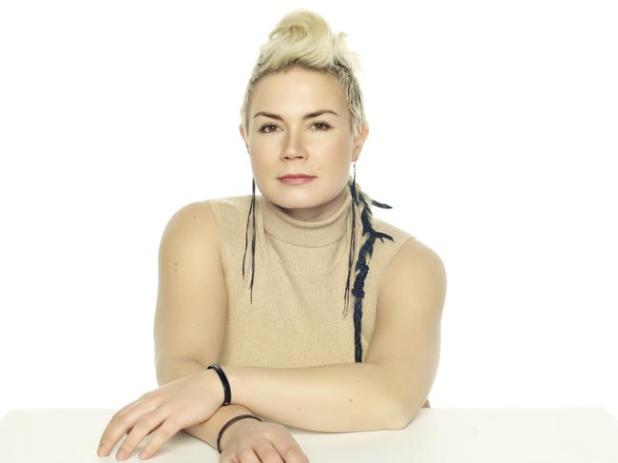
In your latest collection My name is Kenneth. What’s your problem? there is a clear influence of your favourite rock bands and artists in the designs, naming them after those ones. Is music a very important part of your life and an inspiration when designing?
My latest collection My name is kenneth, What’s you problem? collection models are named by the artist and bands I have listened and which I appreciate, but also because they have their own kind of historical style genre I find interesting. I get my inspiration from music. I do everything with music, I mean everything. I was born with music. Thanks for my dad who had loudspeakers in every god damn room at our house. It depend on the feeling I have at the moment what kind of music i need to act. If i need to focus, I usually play music without any lyrics. If I go jogging, it has to be power – even aggressive – music. I was asked to go to Iceland to keep a course for children, and the idea was to play different kind of music, different kind of genres of music to them and to see what happens in the imagination and thirdhand works. We didn’t get funding, so maybe we’ll make it happen next year.
Are there artists-bands that you would like to dedicate new designs in the future?
The models I design and make in the future are of course surrounded and surely inspired by music too, but I have no idea yet am I going to name even one more model after any musician. I follow my guts… so nothing is complete, until I get the idea in my head what the model looks like. But one thing is a fact, I feel my stuff belongs next to music. Not just because I get inspired by music and its artists, but because it feels right and natural. Performers have a right and also a kind of a obligation to dress up more visual way than ordinary people, so that’s when I step in the picture. I’m quite good in visualizing what they like, and would look good wearing without losing their credibility.
During last year, Helsinki was the World Capital of Design. What makes this small and cold country such a good place for successful designers to pop up so often?
I think finnish people are survivors. We have a lot of strength – when we really want something. We can deal the cold weather as well as bad financial circumstances.
“I do everything with music. I was born with music!”
What other young Finnish designers would you recommend to follow?
There is 2 designers I recommend on following: Outi Pyy and Mert Otsamo.
You collaborated recently with your designs in the gala of the Golden Globes Awards in USA. Could you tell us more about it? How that collaboration happened and who was wearing your models?
I went to show my designs in pre Golden Globes in January, because I was asked to. They found my label from a fashion fair 2011 and were following me through internet over one year and then contacted me. First I thought it was just junk mail, but after doing some research, I found out from two of my friends, that it wasn’t actually a joke. So I went there, got t know real people, but mainly few really important contacts. I’m going back to LA in the end of April. I’m gonna meet few actors, one producer, one director and some contacts from commercial field: I’m gonna get gTIEs women’s collection in one store and men’s collection to another store there.
What do you enjoy doing when you are not working? Do you assist to a lot of live music gigs around?
When I’m not working, I’m writing, and drinking some beer like some finnish people do. I go and see gigs, summertime I ride a motorcycle, sports keep my mind straight and makes me like myself more. I love singing. If I get blind, for some reason, I will be a singer.

What can you tell us about your own label gTIE and other collaborations you have around, like for example with Matex Oy?
gTIE turns next week officially 6 years. What I do now for my living is just great. Besides designing for men and women with my own label, I design a men’s line for Matex Oy, the biggest and oldest finnish tie company. I don’t design ties there, but substitutes for ties. Basicly the same thing I do for gTIE but more mainstream way. Matex has the marketing contacts to all biggest stores in Finland, such as Stockmann and Sokos, so as a designer i don’t have to worry about selling strategies and all that “shit”, i can just design. Matex has a lot more powerful engine in their vecihle comparing to what I can do inside of my own label. They offer me a possibility for example to desing my own fabrics. In my own label I don’t have that kind of possibility, mainly ’cause of financial facts.
In the end of March, we publish a new collection for men with Matex named as White Wedding. It’s a wedding collection. And as a designer, I’m gonna make a statement with it aswell. In Finland gay people can’t get officially married, they can just register their relationship, and I think it’s stoopid: First of all it’s against the basic human rights and second, it is jurydic idiotism not to have the same law rights that hetero sexuals do automatically when they get married. So I’m gonna shoot part of the collections catalogue pictures with gay men.
Besides working as a neckwear designer, I have lot’s of product collaborations going on for example with Radio Rock (national radio station in Finland), City of Pori (my home town, they’re actually my sponsor and I’m writing a blog for them) and Porispere (rock festival in August).
I design also clothing for theatre projects, for dancers. For example Aftertaste (2012) and Kaksin käsin (free engines translation With Both Hands, 2010) were my designs. Now I’m making a short movie with modern dancers called Surface Tension. I’s coming out in Autumn. I design and style musicians, artists and bands for their videos and album cover shootings. Top finnish rock bands like HIM, Amorphis, Jari Sillanpää, Lapko and Michael Monroe have worn my designs. I also teach children and teenagers in art schools in Helsinki and Järvenpää. Mainly I do courses in arts and crafts. And all this makes me a really happy woman.
What are your next projects for this year 2013?
My projects for this year are of course making my brand break. I’ve done almost everything I can to make people know it in Finland. Now it’s time to move forward. And for some reasons many signs show me the way to LA. One of my biggest projects besides my ow label this year is doing the whole clothing design for one movie which had a funding from Hollywood. The shooting time is not clear yet, and anything can still happen with that project but if it happens, I will be even happier woman.
Anything to add for the readers?
I would like to say: Believe it, you will get it. The most important sense is intuition. You just have to learn how to hear it. And believe in it. It’s in the guts!
Written by Eva Blanco Medina
Street Art is finally determined to conquer the public spaces all around the world. Going from small populations that sometimes see their essence reduced to the highway exit number they represent on the map, to those cosmopolitan cities where the reinvented hipster urban culture (people riding retro-bicycles in their cool hats, checked shirts and carefully worn out jeans) seem to be melting the snow.
Las Matas
And that is how, leaving the A-6 highway at exit 24, we arrive at Las Matas – a tiny town located in the Northwest area of Madrid, Spain. The inhabitants of this quiet-to-the-boring place spend their lives surrounded by holm oaks and a never ending succession of residential neighbourhoods, a routine just altered when a new restaurant opens its doors, or when once a year, on the first of May, everybody gets extremely drunk celebrating the municipal festivity.
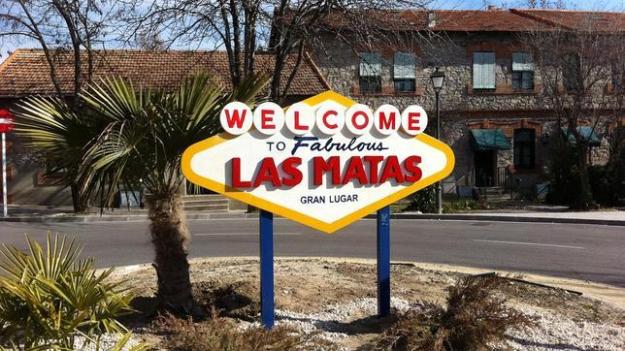
So, last Christmas, on the morning the villagers woke up to a bright rhombus-shaped sign, placed in the middle of the roundabout that gives access to the district, a mix of confusion and pleasant surprise sparkled the air. ” WELCOME TO Fabulous LAS MATAS. Little Town”. That was the readable message on the board. A creative work done by a fine arts student as a copy of the one that stands in the American Capital for gambling, Las Vegas. The funny thing is that we could play a new version of “find the seven differences” using images of both places each side of the page, but this time we would have to call it, “find the seven million differences”. And that is why the sign was so warmly adopted by the villagers. A pinch of irony accompanied the thought that Las Vegas was so, so far away, maybe not even in the same Galaxy, and, at the same time, that was such a relief.
Then, the Town Hall realized that the sign had been placed without the pertinent Administration´s permission, and thus, it was removed. But just temporarily, because people have the bad habit of fighting for the things that make them smile, and so the locals decided to use the social media tools to start a supportive campaign, so that they could keep their new (and fresh) identity symbol, and eventually, it worked!
Stop töhryille-projekti
Töhry is the Finnish word that describes a “mess” in a wall. From 1998 to 2008 the City of Helsinki developed an annually renewed initiative called the “Stop töhryille-projekti”, whose aim was to remove graffiti, stencils, stickers or any other kind of street art expression from public space. In order to assure the walls would remain clean, the City relied on private security operators such as FPS, a company founded in 1997, whose power and influence were specially reinforced over the (also known as) zero tolerance period. However, in 2003, scandals based on the aggressive strategy followed by FPS to fight what they labelled as vandalism damages, started to appear in the media. There were some testimonies from youngsters reporting how they had been beaten up or mistreated by the security agents when they got arrested for supposedly being graffiti painters.
“Fifteen year old guys were hit and fined during this period“, says Kukka Ranta, a very fluent in Spanish journalist and photographer, who, together with Mikael Brunila and Eetu Viren, wrote the book “Muutaman töhryn tähden” ( an investigative work to provide an in-depth perspective on this recent decade). Then, while nibbling at a non-curved croissant, she explains that the system established for the payment of the fine added on 16% annual interest if the fee remained unpaid. “This regulation led those teenagers who had been fined to a very complex financial situation in which asking for study grants or any other kind of private loan would be no option, given that they had already contracted a large debt with the Administration”, and Kukka continues, “Isn´t that the best way of ruining somebody´s life for having done a harmless minor act?“.
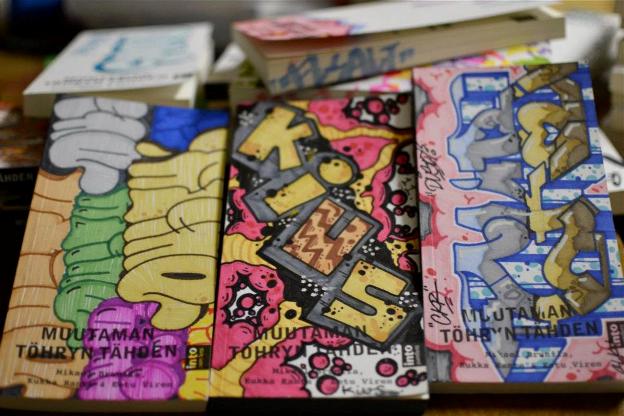
One of the inflexion points was in 2006, when somebody posted a video on Youtube that showed a man being hammered at night by a couple of FPS security agents. The scene occurred in Kontula – one of the most conflictive suburbs in Eastern Helsinki with a serious problem of alcoholism. The publication of these images, together with other initiatives such as the demonstrations organized by leftist political groups, the pressure put on the issue by independent media and online fora, and the creation ( by Kukka Ranta herself and her colleagues) of a website where critical voices surrounding the “Stop töhyille-projekti” were gathered, precipitated the end of the programme two years later, in 2008. By that time, a new discussion based on the possibility of opening public spaces for new artistic purposes, rather than strictly commercial ones, was starting to take shape within the Helsinkian society.
Multicoloured Dreams
The story of the “Multicoloured Dreams” (MCD) project starts, like many others, with a visionary idea. And the first driving force behind it was Pauliina Seppälä (journalist and sociologist) who at the beginning of Summer 2010 launched a question to a Facebook group called RHC – a refugee hospitality club Pauliina herself was coordinating- wondering if anybody would be interested in painting street art messages on construction site walls. The previous year, construction sites in Helsinki began to have plywood walls put around them, which, scrutinized by an incisor look, provided the perfect temporary canvas for a new treatment of street art, which would start being legally protected… without giving up its provocative component.
There were two people who immediately accepted Pauliina´s offer: Satu Kettunen, still one of the leaders of the MCD crew, and an Indian architect named Kavita Gonsalves who was then living in the Finnish Capital. “I must admit that it was a really happy coincidence that the three of us got together, because we were a good combination of vision, devotion, thinking outside the box, and all with hands-on attitudes. So very soon we had planned a nice project“, explains Satu when asked about the beginnings of the initiative. The first thing they did was to suggest having the project included on the official calendar for the upcoming Helsinki Design Week, and, when the organizers of the event accepted, they continued the process by asking for the City Architect´s permission. With the eagerly awaited green light, there was just one more thing to do: spread the word around the social media, so that every artist wanting to participate in the project could have the sketches prepared to be approved. Satu also considers that their modus operandi, based on the ultimate respect for the political and social authorities, helped them succeed in their approach, “The fact that we were politely asking for the permissions, and showing them the sketches before painting…the whole procedure seemed to fit here. They trusted us”.
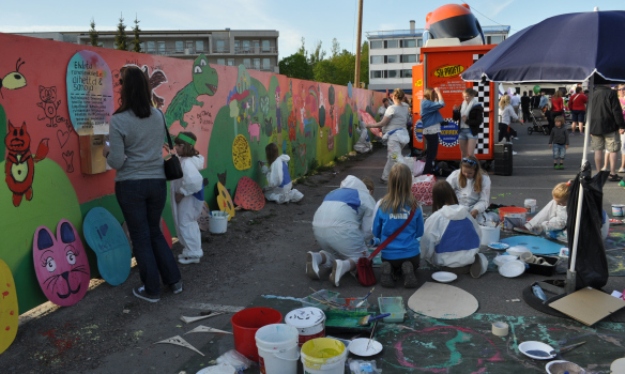
After the open-call projects developed for the Helsinki area in 2010 and 2011 (both based on voluntary work, meaning no institution was financially backing up), there is one assignment that occupies a significant stage in the trajectory of MCD: a big, half-year-long, project made for the City of Kauniainen, located inside the Espoo area. Its skeleton as a whole included street art workshops for students and seniors, a painting day for kids, a couple of artworks produced by the 8 people who belonged to the coordinating team and an invitation to Otto Maija to act as a guest artist. The City commissioned all the activities, the teaching, the organization and the painting itself, and this gave regular citizens the opportunity of playing artist role for some days. Not only could they explore their hidden talents and creativity but they could also contribute to the beautification of their home town.
Applying for grants is one of the main tasks the MCD team has to face in order to assure the growth and social impact of their association. “More street art projects need to happen in Finland, that way, the financial support will also increase. That´s how the grant policy works in this country“, says Satu, always pointing out that their goal is far from creating a profitable business. In the same sense, Veera Jalava, a younger -but equally attractive- version of the actress Anna Torv (Fringe), and another member of the MCD organisational team, remembers that “the original philosophy of the initiative relied on voluntary work. It wasn´t thought of to earn a living out of it, but to make the city more alive. To give wider possibilities to everyone to do street art“.
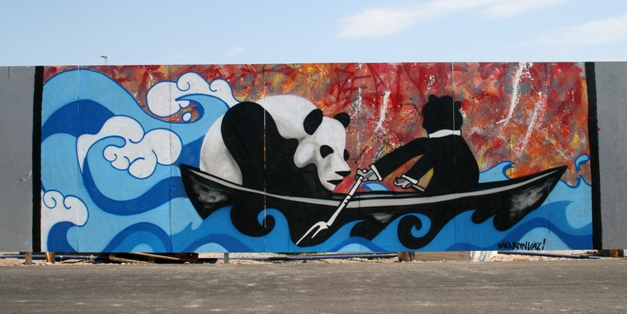
Antti Mannynvali agrees to this non-profitable perspective. The artist, who has contributed with his talent to one of the MCD projects in the centre of Helsinki, considers that voluntarism is a core issue, “for me, this is something that is aimed at those who just want to produce visible art. The motivation for doing this is not money. But even then, since the visibility provided here is hard to reach otherwise, that could culminate in other gigs which might involve getting paid“. Then, when asked about the relationship between the city and the possibilities for street art, he claims, “A large part of public space could be open to artistic expressions. It is something that interests and motivates young people to be creative, and I think society should try to encourage them in a positive way. For a long time they spent humongous efforts trying to marginalize those youngsters and force them into becoming hard criminals. I can’t understand that approach.”
Finally, the Multicoloured Dreams project has also been the target for some criticism from the so-called purist sector, those grafters who claim the nature of street art to be illegal, and asking for permissions and handing in sketches to be approved is far from its essence. However, Satu makes herself very clear regarding this point, “I don´t think we are taking anything away from the illegal painters. We haven’t had many old school graffiti artists taking part in our projects, but they are also very welcome. I believe that people need the possibility to make a difference to their surroundings, to leave a mark…to take the city streets for themselves away from the commercial companies“.
The New Chapel of Silence in Helsinki
Text and photos by Eva Blanco
Everybody would agree that if there are issues to complain about in Helsinki, noise would certainly not come at the top of the list. The Finnish Capital is inhabited by over six hundred thousand people – much larger than any other city in the country…but they like to play it quiet. No shouting on the streets unless you are actively taking part in the Saturday night fever. No hell melodies performed by friendly drivers who love honking their horns. And, in case you didn´t realize, stress is nowhere to be seen. So why? Why the need for building a space to honour silence and inner peace right in the heart of the town when such a calm atmosphere is already available? Maybe just because quietness is as addictive as chocolate, you could always do with a little bit more.
Located in a corner of the Narinkkatori square, where, thanks to the persistent direct marketing campaigns, you can usually get a snack for free, with its wooden surface mysteriously gleaming even on rainy days, the Chapel of Silence (also known as Kamppi Chapel) is intended to be both a place for personal reflection and a platform of social commitment. A dual personality easily recognizable starting with the architectonic design – before getting to enter into the chapel you have to cross a small foyer where round tables have been set up for small-scale gatherings and one to one conversations in which God doesn´t need to show up unless he is specifically required to. Forgetting about all kind of ornamentation, this solid oval-shaped structure is raised up from the ground as an interpretation of a modern wooden church which has deep roots in tradition.
It was the former Helsinki’s Deputy Mayor Pekka Korpinen who, after travelling around Italy and witnessing its variety of sacral spaces for momentary withdrawal, came up with the idea of transferring the concept to the Baltic city. That is how the initiative started to take off in 2008 when the architects from K2S studio, Kimmo Lintula, Niko Sirola and Mikko Summanen, were chosen to design the Chapel, but it wasn´t until May of this year when it was finally opened to the public as part of the World Design Capital program. Counting on extensive background from the construction of public buildings, such as a hospital in the city of Espoo or an IT-college in the town of Sipoo, Summanen (head designer) still thinks that this project holds incomparable value: “Kamppi Chapel is an island of peace and spirit within the commercial flux. It is an architectonic interpretation of gentler human values deliberately contrasting with it’s surroundings. The possibility to build this unique piece in the centre of Helsinki was naturally a once in a lifetime experience“.
Then, when asked about the most meaningful stages of the process, the architect explains: “It was very important for us to discuss the spirit of the place. The feeling of the material and form as well as the changing natural light are the essential components that define the atmosphere of the chapel space itself. Our aim was to create “human scale monumetalism” in the interior – where although the dimensions are small there is still a verticality that elevates the space“. Precisely this condition of verticality, that Mikko tries to empathize, is one of the main factors that contributes to overwhelm the almost two million visitors who have stepped into the Chapel so far. Coming from Finland and smiling openly to everybody as if that was the most natural thing to do in this country, Mary, a slim middle-aged woman, forgets about technical terms and puts it in her own words…”It feels like an illusion“.
The power structures within the Chapel are also a defining element. The building is operated, on a partnership basis, between the Helsinki parish union and the Social Services Department of the city. A total of twelve employees (six related to each institution) were hired to work together looking after the place and making themselves available for personal discussions. “Cities and churches have worked side by side all around Finland, but not this way. Not so close, in the same room. Not with a shared goal and organization”, says Tarja Jalli, manager of the Chapel, and then he goes further analysing this collaborative initiative: “We have found a nice synergy together. Our palette of services is now twice as big as it used to be, which means that people can get much more help at the same time“.
This opinion is also shared by Pekka Uula, one of the employees who shows the genuine appearance of a rock band guitarist and talks with enthusiasm about the project. “So far it´s working great!”, he claims, and later on he summarizes the whole philosophy of this original association: “There are people that may not feel comfortable talking to a priest. That is why we also need to offer a non-confessional option…I would say that even if it is a Lutheran chapel, it is not religious in a way“. Reaching out to everybody is a key issue to complete successful work. In the end, if you suffer from loneliness, illness or because you are going through a tough family situation- the three main reasons that make people search for comfort in this place- the last thing you should care about is if you have enough faith to be welcomed to talk about it. That is where the peculiarity of the Chapel lies. Well, and maybe also to a certain extent on its active social network profile. So far it has accumulated more than one hundred tweets – basically memorable quotes- and over nine hundred “likes” in Facebook.
On the other hand, arranging a personal communion at the Chapel is possible if you ask the priest beforehand. The priest, being a blond haired, blue eyed, kind woman named Nanna Helaakosici. She explains that church services such as baptism or wedding ceremonies, with the exception of the one that will be celebrated the twelfth of December (12/12/12), are not held in here. Nanna remarks that the building is not supposed to be reserved for private use. However, included on the weekly schedule we can find regular moments of prayer that may be accompanied by background music.
The rest of the time this place belongs to you. To all of us. And here lies the problem. At the “Chapel of Silence” silence itself is still an intermittent guest. It can honour the visitors with its presence for a maximum of five minutes, but then suddenly just when you are starting to feel adapted to the peaceful environment that keeps you safe from the hustle and bustle of the city, the door is opened again and a group of tourists are marched in!.
In a few seconds whispers spread all around the wooden structure, in fact, there are cases of people that forget to switch off their mobile phone and then quickly try to do so when their partners are ringing just to check if they have bought some coffee. How to keep silence for a longer time is still an issue that needs to be figured out. Although we will just probably have to wait until the excitement about the building is over before we see that happening. Despite that, the Chapel is destined to become one of the most iconic places in Helsinki. An inspiring shelter where life stops for a little while so that you can sort out your thoughts and regain your strength – with or without God.
The programme of the Baltic Circle Festival 2011 has been published and tickets are for sale. In addition to international guest performances, the festival features international co-productions and performances produced by Baltic Circle. These performances bring on stage the emerging artists and new trends of performance art at the moment. At this year’s festival, we will see five premieres, which are produced or internationally co-produced by Baltic Circle. The festival takes place in Helsinki from 16th to 20th November.
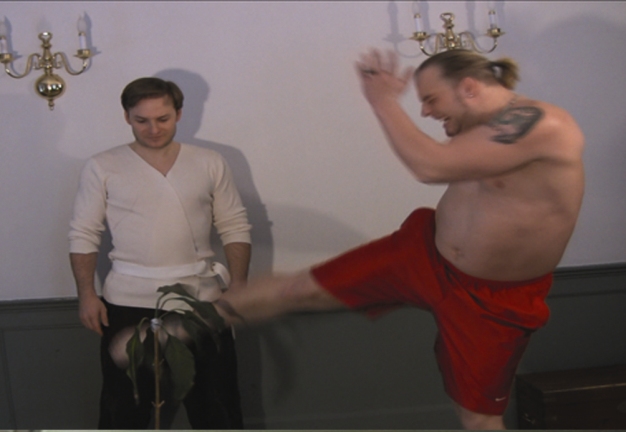
This time it’s personal
The festival presents a new international generation of theatre artists as well as several rising talents of the Finnish performance art. Baltic Circle Festival includes a number of performances, which get their inspiration from personal experiences, comment on the role of art and take part in social issues through art. As Festival Director Eva Neklyaeva puts it “This time it’s about reclaiming the stage. This time it’s personal.”
Read more about the entire programme: http://balticcircle.fi/
See the hot trailer: http://vimeo.com/23544033
BALTIC CIRCLE 2011 PROGRAMME:
Katariina Numminen / REALITY RESEARCH CENTER (FIN):
DRAMA RELOADED: YERMA
WED 16.11. 17:00, THU 17.11. 17:30, FRI 18.11. 20:00, SUN 20.11. 16:00 & 19:00
Puoli-Q, Tunturikatu 16
20 / 15 €
REALITY RESEARCH CENTER / Pekko Koskinen (FIN):
STAGED LARCENY: AN EXPERIMENT
WED 16.11. 17:30 & THU 17.11. 17:30
Hurjaruuth, Kaapelitehdas, Tallberginkatu 1 A / 117
Includes the Doris Uhlich performance more than enough.
20 / 15 €
Doris Uhlich (AUT): MORE THAN ENOUGH
WED 16.11. 18:00 & THU 17.11. 18:00
Hurjaruuth, Kaapelitehdas, Tallberginkatu 1 A / 117
20 / 15 €
Andrei Andrianov & Oleg Soulimenko (AUT / RUS): MADE IN RUSSIA
WED 16.11. 18:00
Korjaamo, Vaunusali, Töölönkatu 51
20 / 15 €
Ojanen & Iivanainen (FIN): FAT BASTARDS
WED 16.11. 20:00, THUR 17.11. 20:00, FRI 18.11. 17:30 & SAT 19.11. 17:00
Suvilahti, Tiivistämö, Kaasutehtaankatu 1
20 / 15 €
Nya Rampen (FIN): WORSHIP!
WED 16.11. 20:00, FRI 18.11. 20:00, SAT 19.11. 20:00 & SU 20.11. 17:00
Mediakeskus Lume, Hämeentie 135
20 / 15 €
Verk Produksjoner (NOR): BUILD ME A MOUNTAIN!
THUR 17.11. 20:00, FRI 18.11. 18:00, SAT 19.11. 14:00 & SUN 20.11. 14:00
Q-teatteri, Tunturikatu 16
20 / 15 €
Zachary Oberzan (USA): YOUR BROTHER. REMEMBER?
THUR 17.11. 20:30 & FRI 18.11. 20:30
Korjaamo, Kulmasali, Töölönkatu 51
20 / 15 €
Johanna Lecklin (FIN): TUNNUSTUKSIA
SAT 19.11. & SUN 20.11. 12:00-15:00
Spectators are admitted in one by one, in order of arrival. The duration depends on the length of the confession.
Puoli-Q, Tunturikatu 16
Free entrance
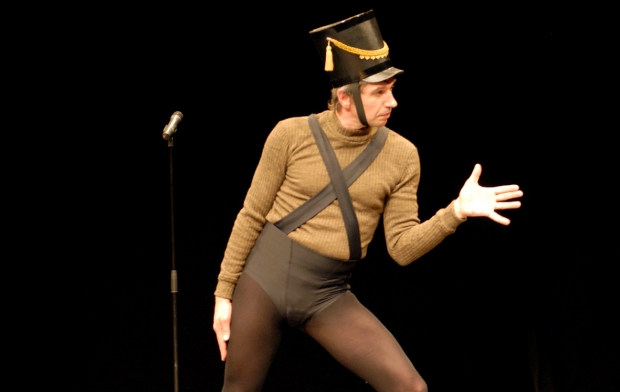
FESTIVAL LOUNGE PROGRAMME:
Universum, Perämiehenkatu 13
FREE ENTRANCE
Amund Sjølie Sveen (NOR): SOUND OF FREEDOM
WED 16.11. 22:00
Kviss Búmm Bang (ISL): SAFARI
THUR 17.11. 22:00
brut Wien (AUT / RUS / USA): A BALTIC NIGHT OF BRUT SOUNDS AND LOST MUSIC
FRI 18.11. 22:00
HOMOPOMO (FIN): THREE LOVERS FEAT. PINK TRIANGLE DANCE GROUP
QueeNNaive (EST)
SAT 19.11. 22:00
Teatteri Venus & Co: KUDOSKLUBI (FIN)
SUN 20.11. 22:00
Susiklubi: HUKKAHUONE
16.11.–20.11. 21-02
Festival Brunch
19.11. & 20.11. 12:00-14:00
Q-teatteri, Tunturikatu 16
10€
Food tickets can be purchased in advance from Q-teatteri or Lippupalvelu (Ticket Service Finland).
Q-teatteri
Tel. +358 9 4542 1333 (Tue-Fri 11:00-15:00)
Ticket Service Finland
Tel. +358 (0) 600 10 800 (1,96€/min + local network charge)
www.lippupalvelu.fi
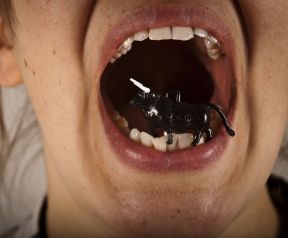
BALTIC RE-CIRCLE
The clothes of the BALTIC RE-CIRCLE fashion collection can now be purchased at the design and art store Myymälä2 in the center of Helsinki and also in November at the Baltic Circle Festival.
Milja Nevalainen and Hannele Äijälä from School of Art and Design have designed the re-design clothing collection of the Baltic Circle Festival. Tsto Agency has designed a BALTIC RE-CIRCLE label that can be seen in the clothes inspired by the colorful days of Twin Peaks, black coffee, cherry pie – jazz and the darkness of the night.
Shop till you drop!
Myymälä2
Uudenmaankatu 23, 00100 Helsinki
Opening Times:
(Mon & Tue closed)
Wed-Sat 12-18
Sun 12-17
FREE BUS TRANSPORT TO THE FESTIVAL LOUNGE
Baltic Circle Festival offers free bus transport to Festival Lounge from Suvilahti, Media Centre Lume and Cabel Factory after the last performances of the day. Please see departure times from the links below.
Wed 16.11.
Fat Bastards / Suvilahti, Tiivistämö
Worship! / Media Centre Lume
Thu 17.11.
Fat Bastards / Suvilahti, Tiivistämö
Fri 18.11.
Worship! / Media Centre Lume
Sat 19.11.
Two in Your House / Cabel Factory, Hurjaruuth
Worship! / Media Centre Lume
Photos:
Jack Balance
Dieter Hartwig
Zachary Oberzan
When visiting a new city, apart from the offer of restaurants, museus or monuments that a new place can offer, the curiosity about the local nightlife scene is undoubtedly one of the most searched items in the net and forums. New bars and clubs to explore are double exciting to discover when the light of the day deems and let the night evolve us, although in Helsinki on summer, you can still feel pretty much daylight in your eyes due to their geographical location.
This is not of course an exhaustive tourist guide with all possibilities to explore in such a big city as Helsinki is, but more a collection of personal observation and hints about my favorite and not so favorite places after having lived, studied and worked for several years in the Finnish capital.

The first important thing to take into account is that Finns drink a lot when going out. So do not be surprised if your perception of Helsinki and its habitants change drastically from daylight to nighttime. What during the day is a mass of quiet and shy people turn into a perfect machine of drinking when the party times of the night comes closer. Due to the price of alcoholic drinks being quite high all over the city (a pint of beer will cost between 5 -7.5 euro depending on the place you hang around), it is a normal tradition to gather with some friends in a house for a warming up drinking session before hitting the clubs and bars downtown.
Although most of the people go out reverently on Friday and Saturday nights, as in most big cities of Europe, actually Wednesdays and especially Thursdays are also days where you can find the bars pretty crowded. Remember that Helsinki is a University City, so during the scholar year, it is normal that many parties for University students take place on Thursday, because on Friday they come back to their hometowns for the weekend.
It is also recommended not to leave very late towards the nightclubs, partially because the neighbors can feel annoyed because of the noise, and partially because the unpleasant tradition of the queues in most of the popular Finnish nightclubs and bars. Even when the place can be half empty inside, for many Finnish clubs seem cool to make people wait outside in endless queues. This can be sometimes a good chance to make acquaintances and new friends while waiting, but believe me, on winter time, it is not so nice to wait half an hour queue with minus 25 degrees and a snowstorm over your heads.
On the other hand, dress code is usually pretty relaxed in most of the clubs in Finland. Just wearing jeans and sport shoes will allow you entrance with no problems, although of course for some more nose up luxury places, like Tiikkeri club, it is recommended to dress up accordingly
In basically all or most of the clubs and bars in Helsinki, you will have to pay for a service fee, using or not using the wardrobe, that is around 2.5 euro, and it is paid separately from the entrance fee. If you live your jacket, you will receive a ticket with the number, so try not to lose it, because getting your jacket back can turn into an odyssey if the bouncers and personnel are not friendly to trust on you.

Some of the easiest options for the visitors are located just in the heart of the city, like in Mannerheinmintie, the main avenue. There for example you can visit Apollo Live Club that seems pretty popular among Finns lately, but honestly, when I visited a couple of times, I got disappointed. The best part is that a count with live bands, but it is usually too crowded and customers are not the friendliest in Helsinki. Better options, also located close in Mannerheinmintie, is Cuba, a bar-club that counts with free entrance, and where it mixes a heterogeneous crowd of Finns who love Latino music and expatriates.
At this point, many of the readers will wonder how easy or difficult is to score and have some romantic fun with a Finn (let´s be honest, is that not the main reason why the single people go out ;) ).
Certain specific rules have to be followed in Finland that differ from other countries for example, it is normal that at the beginning of the night, the girls are the first ones “breaking the ice” on the dance floor. So it would not be uncommon in a club that you could go to the dance floor, and you would be surrounded by 40 women. But do not get mistaken, that does not necessarily mean that they are single. A bit later at night you will see how many of their boyfriends “pop out” magically out of nowhere. In Finland, the behavior of the people is much more independent than in other European countries, so a couple can be perfectly by their own with their common friends inside the same nightclub without having to be all the time sticked to each other´s back. So be sure that your target is single, if you do not want any unpleasant surprise when making your move.
All in all, mentality of Finnish people is quite open minded and relaxed about having some random fun and romance during the night. Although Finnish men are a bit shy by nature, alcohol makes them more open and friendly, although watch out, because sometimes, when they go off the hook, they can turn into a bit annoying or even agressive if a couple of too many vodka drinks were consumed.
As previously stated, Finnish ladies are quite independent and strong, so do not be surprised if some of them just make the first move on you. Nevertheless, this is the country of equality! Also, in some circumstances, small talk is not so needed like in other countries. It is normal that in the dance floor people start to rub and dance with each other quite flirtatiously without having exchanged a word, but once again, you have to read the signals correctly if you do not want to get anybody angry for miscalculating your attack…
Although gay scene is not as big as in other European capitals, there are also a couple of reference places to go. DTM (Don´t Tell Mamma) in Iso Roobertinkatu in Punavuori district is one of the most popular ones, but be ready to pay 8 euro entrance at weekends. Close to it there is the free entrance Lost & Found, which in later years has become more and more hetero friendly. Legend said that Ville Valo, the charismatic leader of the love metal band H.I.M. used to hang around there, but honestly, I have never seen him, and I have visited the place quite often, being very popular among students in Helsinki too.
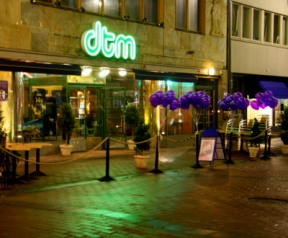
Being Finland the country of heavy metal music, if you dig it, you cannot skip visiting the most legendary metal club in town, Tavastia, located in Kamppi district, where basically all the most famous bands play or have played at some point of their careers. It is not unusual that local artists hang around there, and the list of concerts through the year is pretty good. Not far from it, also in Kamppi, are located Bäkkäri and Heavy Corner, two good options for metalheads if you want to continue the party after watching a gig. If you prefer a bit more classic rock and alternative pop atmosphere, Bar Loose is your choice. The changed to a bigger venue a couple of years ago, and they offer also a great selection of live gigs at their down floor, while upstairs is always nice to have some beers or a coffee with friends. One of my favorites in town.
If you like Irish pubs and a very international atmosphere, your best choice is Molly Malone´s, near the Railway Station Square, that offers live concerts every night, and that recently had been enlarged, with a new dance floor. It is packed with the foreign community of Finland, but also the more international oriented Finns go there. If you like an atmosphere more 100% Finnish, try the very popular Kaarle XII nightclub, known commonly by natives as “Kalle”. In its 2 floors you can find very different atmospheres and kind of music, and a bunch of Finnish animal parties ready to give their best. The entrance is free on Thursday, a very good day to visit because many locals start their long weekend there.
All in all, Helsinki is a vibrant city with many more great venues offered to enjoy the night. Just go out, explore it, and probably after warming up your body with a couple of drinks, you will have a better view of an important side of Finnish culture. Or maybe you will find some Scandinavian romance and love…!
http://www.kaarle.com/fi/
http://www.cubacafe.fi/
http://www.apolloliveclub.fi/
http://www.mollymalones.fi/
http://www.lostandfound.fi/
Estonia’s soul singers
{mosimage}For a small country, it has a big voice – many thousands of them. While most nations measure their international prestige in sporting or economic terms, Estonia prides itself on its singing.
T
he 25th Song Celebration (Laulupidu), titled “To breathe as one”, was held at Lauluväljak (Tallinn Song Festival Grounds) on 2-5 July and its importance to the Estonian psyche cannot be exaggerated. The last in 2004 attracted a crowd of over 200,000 plus 35,000 choral singers and 2,000 musicians raising their voices in traditional and modern song.
Fittingly, a statue of Gustav Ernesaks (1908-1993), 'the Father of the Festival', has looked down over the vast field since 2004 to the huge arched roof under which the choirs perform. He was the event's head organiser and chief choirmaster for nearly 50 years as well as being a noted composer who put to music Mu isamaa on minu arm (My country is my love) the poem by Estonia’s pre-eminent female poet Lydia Koidula.
“This song is very important for all Estonians, it’s the symbol of our freedom,” says Margot Holts, Lauluväljak’s Marketing Director.
2009 marked the festival’s 140th anniversary and it has mushroomed in significance and size from its origins in the city of Tarttu, where a small museum traces its history. Naturally, during Estonia's Russian and Soviet periods, it acted as a siren for the Estonian soul. So why was it allowed when Estonia was part of the Soviet Union from 1944 to1991? (The current TSFG was even built in 1959 although the then radical design was by Estonian architects Kotli and Sepmann)
Blissful Ignorance
{mosimage}"The powers in Moscow saw it as a cultural event only. They were so far removed that they didn’t realize it was so totemic for us,” explains Mall Oja of Tallinn’s Tourist Bureau.
During occupation, it was held with red flag flying, while the throng defiantly sang for freedom. Before independence came in 1991, the last Soviet event attended by 300,000 in 1988 was dubbed ‘The singing revolution’. This and the subsequent one in 1992 exhaled pride and joy which was breathed in deeply by the entire nation.
Plucked young, matured carefully
Since 1934, the festival has been combined with the Dance Celebration (at nearby Kalev Stadium) that has now had its 18th edition. Over 50,000 choir and 20,000 dancing applications (from abroad too) were received, which were whittled down – only the best will do.
Estonian choristry skims off the cream from an early age – mirroring the process of the sports world. Choristers from village to city join a major choir as young as five years old. The gifted are trialled, selected and trained at such elite bodies as the Estonian National Opera Boys’ Choir.
{mosimage}Under the professional tutelage of ENOBC's Artistic Director Hirvo Surva and others, they are trained in breathing, singing and timing. Estonian choirs have received applause and awards abroad from the Llangollen Choir Competition and Hungary’s Cantemus Choral Festival among others. Singers and dancers this year came from North America, the Nordics, UK, Ukraine, Hungary and Russia.
A typical participant was Feliks Mägus, Chairman of the Nordic Hotel s group who joined a choir aged 7 and then sang until he graduated, literally, to the Tarttu men's choir Akadeemiline Emajõgi. As he puts it “The Song Festival has always been a place to enjoy singing and to feel that all Estonians are as one nation.”
But the sound and atmosphere created by 100,000 voices is unforgettable in the ten or so songs that are performed together en masse. “Our programme always includes difficult pieces which require balance and careful rehearsal,” comments Surva. “And we always start with Koit and finish with Mu isamaa on mu arm for the older generation.”
Held every four years like the Olympics and other great sporting occasions, this mean that those who take part have an indelible experience. Although not everyone who wishes can attend in person, the volume and atmosphere produced by the ensemble when singing together means that their voices carry far beyond the sound limits and into the hearts and souls of absentees too.
Finland is in the game!
Not many years ago, videogames were still seen as children’s play, with the media usually more focused on polemical issues like the impact of violent content on youngster’s behaviours. Luckily, nowadays the trend seems to be reverted, with more adults watching the videogames market not only as an entertaining, but also as a nice way of making a profitable business. Obviously Finland, a country that boasts its love for new technologies as a national trademark, could not get impartial to the juicy fruit that videogames industry represent nowadays. Finnish game industry is doubling the average growth of its international counterparts, a situation that continues evolving. The industry doubled its turnover in 2007 and places itself firmly in a steep growth curve. The country counts with around 60 companies listed as developers or content providers, adding a similar figure for companies focused on consulting, content creation and other tasks related to videogames. Games in Finland are not only developed for well-established platforms like video consoles or personal computers, but also for arising markets like mobile phones or online social networks.
Espoo, Pasila and Mark Wahlberg
Espoo is a city located just close to the capital Helsinki. And no, it is not that the American actor has not bought a house there (yet). Espoo is the location for the headquarters of Remedy Entertainment, the “fathers” of Max Payne character. Probably some of you have watched in the cinemas this year the last successful Wahlberg’s performance in the role of Max Payne but maybe you did not know that the character was born in Finland, with a videogame released in 2001 that quickly caught the attention of millions of fans, and developed into a sequel: “Max Payne: The Fall of Max Payne”. The saga is the most successful one in Finnish game industry, having sold so far more than 8 million copies for Pc, PS2 and Xbox. “We are thrilled with how well Max Payne has done; a number one game and now a number one movie! The commercial and critical success of Max Payne is a sum of many factors. In the end, it comes down to entertaining a lot of people really well” says Matias Myllyrinne, business director at Remedy Entertainment.
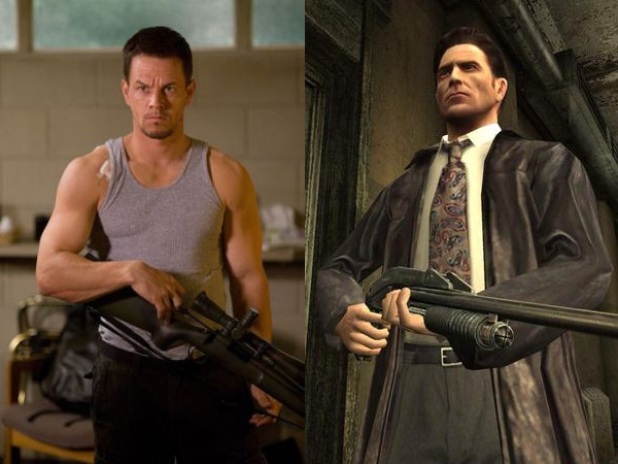
The company is currently developing a new title: “Alan Wake”, a psychological action thriller that will try to continue the path of success of the company dealing with the new generation of consoles and PC, whose release in partnership with the giant Microsoft games supposes another milestone in the history of the company: “There is no room for complacency and we remain hungry to outdo our past achievements; “Alan Wake” must define and establish the thriller genre in games. With Microsoft there is a great fit of complementary talents and a shared passion to create something awesome. Their wide resources and strong and dedicated team allow us to focus on the making Alan Wake the game it deserves to be and to continue our track record of success.
The surroundings of Pasila station, a district near Helsinki centre, do not look exactly flamboyant. Students’ dorms and ugly brick buildings shape this surrealistic landscape. Hidden in one of the buildings are the offices of RedLynx, another top Finnish games developer, creators of the popular saga “Pathway to Glory” and also with a broad expertise developing products for handheld consoles, mobile phones and cross-media entertainment. I even had a job interview them some time ago; I remember that while I was worried removing my earring and my tongue piercing to look more “professional”, I discovered when arriving to their premises that my interviewer had not one but several earrings in his ears. That gives you an idea about the lack of importance that appearances have for games developers and testers. Usually the atmosphere is young and cheerful, posters decorate the walls here and there and the dress code is totally casual, jeans and the t-shirt of your favourite rock band does perfectly the trick. Finnish Game industry is a relatively very young industry in Finland, with the first companies being born in 1994-1995, and most of the employees have not even turned 30. The message seems clear, what the game industry wants is freshness of ideas, not expensive suits at the office.
And luckily, these companies are just the top of the iceberg when accounting successful stories in Finnish game industry. Many others have been able to achieve considerable success publishing games for video consoles and PC like Bugbear, a company mainly focused on driving games, and their splendid “FlatOut” saga, Housemarque with their “Super Stardust”, Recoil and their emotional drama “Earth no More” or Frozenbyte with the revolutionary shooter saga “Shadowgrounds”.
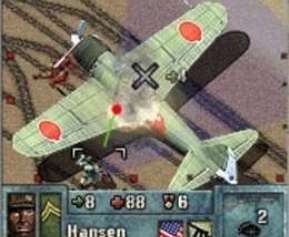
The good thing of creating videogames is that you do not even need a fancy office to put the idea together. Kimmo Vihola is one of the founders of MountainSheep, one small but ambitious Finnish company that recently released the title Super Hind for the portable video console Sony PSP. Just in his mid twenties, Kimmo looks like any other young Finnish “nerdy” student with passion for computers and videogames. Together with some other young partners, he was able to set a game developing company without the need to rent an own office space “We can work from home and thanks to Internet we can have the best collaborators in different fields from wherever country they are; for being in contact they just need a fast Internet connection. Outsourcing is great to reduce expenses, although our business is not so profitable yet” says Kimmo.
The size does not (always) matters
Thanks to the advance of new technologies, nowadays you do not need to carry 5 kilograms of gadgets in order to play your favourite games. A mobile phone in your pocket is all you need for enjoying your favourite titles. Game industry has evolved trying to find new platforms, and currently, with mobile phones that look more like mini-computers, you have no excuse to enjoy playing videogames whenever wherever.
One of the top developers of games for mobile phones is Digital Chocolate, a Californian based company that bought the Finnish Sumea a few years ago. Behind such a sweet name, it is hidden one little colossus of the Finnish videogames scene, with headquarters at Ruoholahti in Helsinki, few steps away from the Old Factory Cable. The atmosphere there is all what you could expect, posters hanging on every wall, a relaxing room where to play “Guitar Hero”, coffee machines prominently placed here and there, and a youthful and healthy international environment. In fact, game industry is one of the most open-minded to hire foreign workers in Finland. Arja Martikainen explains a bit more about the company´s features: “Digital Chocolate has a portfolio of approximately 120 titles. Each month the studios are producing approximately four completely new title or sequel versions of an old title and at the moment there are 23 nationalities working at the Helsinki office.
Official working languages are usually both Finnish and English, or even only English; as well, localization of videogames in the most important targeted languages for release takes place inside the Finnish office, reducing outsourcing expenses and turning gaming industry into a very international environment where foreign and native brains can exchange ideas and work in harmony on the pursue of common goals.
Although many of the most important developers are located in the big capital area of Finland, some other cities have also an important role in the native game industry, especially the ones that count with universities, an excellent source to feed the firms with new young talented employees. For example, in the heart of Tampere you can find the main and trendily decorated office of Universomo, another developer for mobile phones that is living a golden era after its acquisition by the American giant THQ Wireless. This subsidiary relation has opened the doors to mainstream Hollywood adaptations into mobile phone games with titles such as 300 or Indiana Jones and the Kingdom of the Crystal Skull.
Online fun
Another big success in the recent history of Finnish gaming and entertainment is the one achieved by Sulake Corporation Inc, founded by Aapo Kyrölä and Sampo Karjalainen, and well known overall due to “Habbo Hotel”, a virtual world and online community that instantly gained the hearts of the young users, with more than 100 million registered since their creation in 2000 and 10 million unique visitors every month.

Following the trend, another virtual community that is gaining popularity step by step is XIHA Life; co-founded by Jani Penttinen, former game developer for the American giant Electronic Arts, together with his Chinese wife. XIHA offers the chance to meet people from all over the world and much more; users can upload unlimited amount of pictures, discover new music, and of course games are an important part of the fun; as Jani explains: “In fact the idea came mostly from my wife, Wen. The biggest reason for starting XIHA Life was the fact that we had a multilingual circle of friends where people were speaking Chinese, English and even Finnish, but not everyone could communicate with each other. I worked in Las Vegas for Westwood Studios for a few years, until EA closed the studio. After that I still continued to work as a consultant for EA for many of their top projects, while working on my own casual games company, Jollygood Games. I have good connections to the casual games industry from those days, and for that reason games are indeed the main source of income for XIHA”.
Finnish game industry’s key to success has also something to do with the economical support of the government, making things easier when affording the cost of the projects. Opposite to other European countries, Finnish public institutions strongly support the native game industry. Funding per capita in 2007 was 1.20 EUR in Finland, sixty times higher than the average in other EU countries that was just 0.02 EUR. Finnish government has learnt well the lesson, giving value to the expertise of their native companies and realizing that videogames are just much more than a thing to play with.






